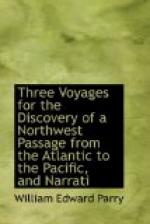Finding, soon after Captain Hoppner’s return, that the current swept the Hecla a long way to the southward while hoisting up the boats, and that more ice was drifting in towards the shore, I was under the painful necessity of recalling the party at the pumps, rather than incur the risk, now an inevitable one, of parting company with them altogether. Accordingly, Mr. Bird, with the last of the people, came on board at eight o’clock in the evening, having left eighteen inches water in the well, and four pumps being requisite to keep her free. In three hours after Mr. Bird’s return, more than half a mile of closely packed ice intervened between the Fury and the open water in which we were beating, and before the morning this barrier had increased to four or five miles in breadth.
We carried a press of canvass all night, with a fresh breeze from the north, to enable us to keep abreast of the Fury, which, on account of the strong southerly current, we could only do by beating at some distance from the land. The breadth of the ice in-shore continued increasing during the day, but we could see no end to the water in which we were beating, either to the southward or eastward. It fell quite calm in the evening, when the breadth of the ice in-shore had increased to six or seven miles. We did not, during the day, perceive any current setting to the southward, but in the course of the night we were drifted four or five leagues to the southwestward.
A southerly breeze enabling us to regain our northing, we ran along the margin of the ice, but were led so much to the eastward by it, that we could approach the ship no nearer than before during the whole day. She appeared to us at this distance to have a much greater heel than when the people left her, which made us still more anxious to get near her. The latitude at noon was 72 deg. 34’ 57”, making our distance from the Fury twelve miles, which, by the morning of the 25th, had increased to at least five leagues, the ice continuing to “pack” between us and the shore. The wind, however, now gradually drew round to the westward, giving us hopes of a change, and we continued to ply about the margin of the ice, in constant readiness for taking




